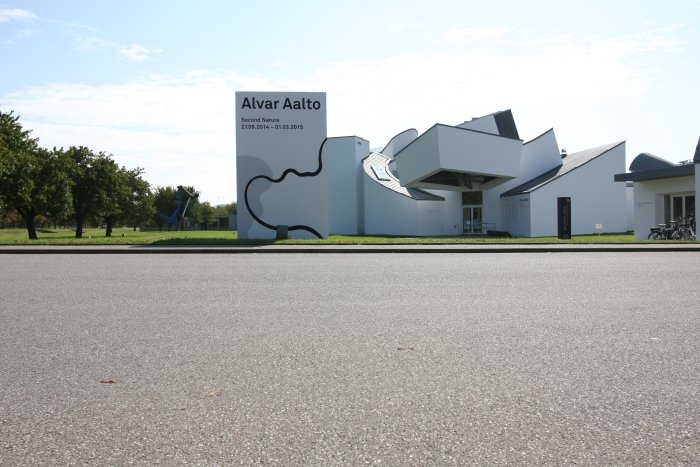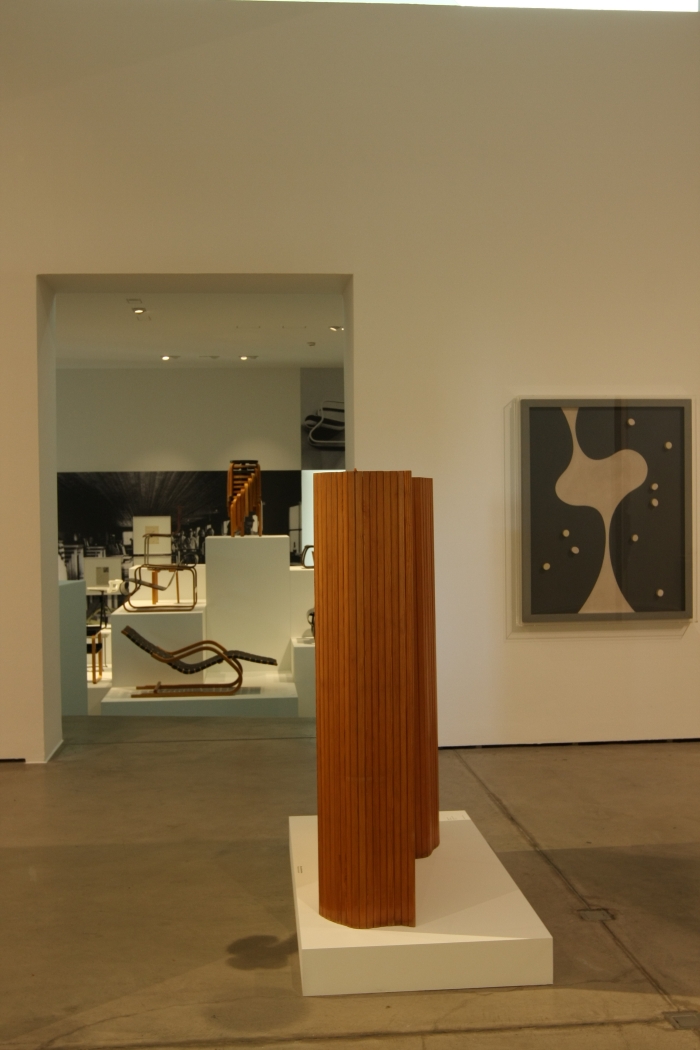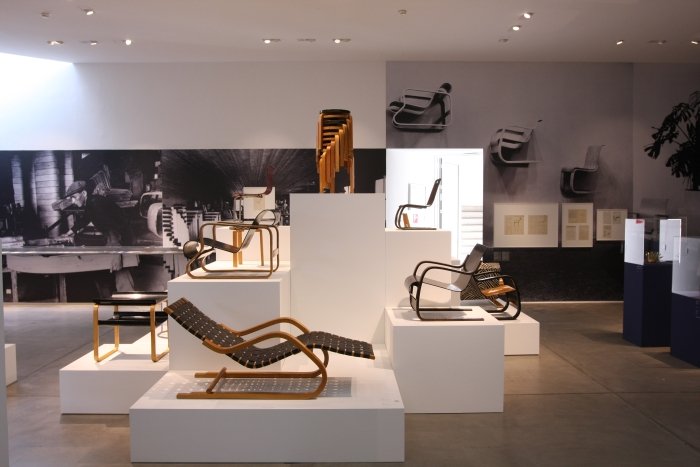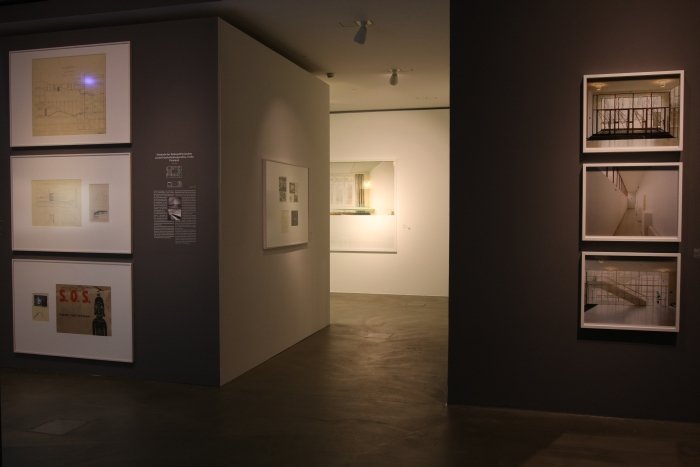Everyone knows Finnish architect and designer Alvar Aalto. Everyone knows his flowing, free-formed buildings and his moulded plywood furniture. What is there new to learn? What is the point in another Alvar Aalto exhibition.
What indeed................................

Born in Kuortane Finland on February 3rd 1898 Alvar Aalto began studying architecture at the Helsinki University of Technology in 1916, graduating in 1921 and established his own architectural practice in Jyväskyla in 1923. In 1927 Alvar Aalto moved to Turku where he became acquainted with the local furniture manufacturer Otto Korhonen, a friendship which would prove decisive in the development of Aalto's career as a furniture designer. In 1932 Alvar Aalto first reached an international public with his Paimio Sanitorium project, before an exhibition of his furniture in London in 1933 both began the global success story of his moulded plywood furniture and also led to the establishing of the company Artek in 1935 to produce and distribute his furniture. There subsequently followed over 300 further architectural projects, both realised and unrealised, numerous furniture, lighting and glassware designs, in addition to awards, exhibitions, guest professorships et al. Alvar Aalto died in Helsinki on May 11th 1976.
That much we all know.
Alvar Aalto Second Nature at the Vitra Design Museum aims to go beyond such and introduce a new Alvar Aalto, to, in the words of exhibition curator Jochen Eisenbrand, "...challenge the established notion of Alvar Aalto as an architect deeply rooted in the Finnish landscape and whose architectural language flowed from there"
If you will, to show an Alvar Aalto beyond Form Follows Forest.
To this end the exhibition is split into four sections, organised in a very rough thematic-chronological structure.
The exhibition opens with a review of Alvar Aalto's earliest architectural works including his municipal library building in Vyborg, the church in Muurame, or the Southwestern Agricultural Cooperative Building in Turku, and ending with his Paimio Sanitorium, the project which in the popular biography of Aalto alluded to above, officially marks Aalto's move from more historical architectural genres to see him fully embracing European modernism and functionalism. A transformation that is often described in the literature as "sudden". But how sudden was it, and what led to it?
""Sudden" is of course a matter of definition", begins Jochen Eisenbrand, "however looking back it is clear that the change happened over a relatively short period of time. For me the background can be found in his travels. In 1928, for example, Aalto undertook his first European tour, in 1929 he partook in the CIAM congress in Frankfurt where he met many leading modernist architects and these meetings and experiences influenced his architecture. At the same time there was also a rising modernist movement in Scandinavia, Aalto was, for example, friends with the organisers of the 1930 Stockholm exhibition, the first manifestation of modernism in Sweden, and closely followed the preparations for the event. Consequently there was a process of events over several years. And if, for example, you study his church projects from that period and compare the early sketches with the later sketches you see how over the years the design for each church gradually moves from Nordic classicism towards a more reduced, modernist, abstract form language"
A further influence on this process of transformation, and for all on the way Aalto developed over the coming decades, can be found in the second room which deals with, if you will, the real meat of the exhibition, Aalto's relationships with contemporary art of the 1920s and 30s and how that influenced his work and his understanding of subjects such as space, light, volume and form. An understanding that in effect began with his exploration of "multi-sensory" architecture as documented in the first room and which later saw him refer to himself jokingly as an architectural "chef d'orchestre", managing the various aspects that are required to make a building a coherent composition just as a conductor leads an orchestra. This aspect of Aalto and his development is presented both in context of artists with whom he was acquainted such as Alexander Calder or Jean Arp, but also through two architecture projects he completed during those decades, the Villa Mairea and Maison Louis Carré, both built for collectors of contemporary art and both buildings which contained gallery space for the collections.

In a delightful contrast to the more challenging experimental exhibition concept of Konstantin Grcic - Panorama, Second Nature is a much more classic exhibition design, which means that in the third room Aalto's furniture and glass design is largely presented on white blocks. A curatorial sin that can be easily forgiven when one sees what objects are on display. In addition to established Aalto classics such as the Stool 60, Serving Trolley 900 or the Paimio Chair there are also fascinating lesser know pieces including the so-called Chair 26, a steel tubing and moulded plywood chair designed for Paimio or, and most impressive of all objects on display, the Paimio Swivel Stool, an object which aside from being a truly beguiling piece of work also bears an immediate and unignorable resemblance to Konstantin Grcic's recent Rival chair for Artek. We're not saying anything. Just comparing. It's our job.
In addition to the questionable white blocks the curatorial decision to present Aalto's furniture and lighting separate from his architecture also strikes us as curious. Aalto's furniture almost always arose in context of an architectural commission, at least in his early years, and as such would it not have made more sense to present them together? "We did consider that subject for a long time" admits Jochen Eisenbrand, "but ultimately decided that in context of our exhibition it was more important to highlight the serial nature of the production, that they were also products that were planned for a mass public and to be produced serially, and so to juxtaposition this applied arts aspect of his career with the fine art influences which helped him develop as an architect and designer."
Rounding of the exhibition the top floor of the Vitra Design Museum is given over to the final section, a look at Alvar Aalto's later architectural projects, for all those that were realised, or at least planned for, overseas, including the Kulturzentrum Wolfsburg, the Baker House student flats at MIT Cambridge, Massachusetts and his 1957 design for a new art museum in Baghdad.
In addition to the exhibition the Vitra Design Museum currently also contains a very large, if metaphorical, elephant.
In September 2013 Vitra acquired Artek. In October 2014 the Vitra Design Museum present an Alvar Aalto exhibition. Good fortune? "As anyone can see the exhibition here took more than a year to organise" replies Vitra Design Museum Chief Curator Mateo Kries, smiling wryly, "the truth is we've been preparing it for the past three years and the fact that in that time Vitra acquired Artek is pure coincidence." In addition we must add that the exhibition passes the "Thonet Test" we developed in context of the recent exhibition Sitting – Lying – Swinging. Furniture from Thonet at the Grassi Museum for Applied Arts, Leipzig; namely, have the commercial interests taken any influence over the museal content? And Second Nature can in no way we be considered an advert for either Artek or iittala,the firm who produce Aalto's glass designs. Both are mentioned, anything else would have been ridiculous, but the exhibition is clearly about Alvar Aalto. Not those who market his designs today.

Featuring some 20 architectural models, 50 original sketches and 60 items of furniture/lighting in addition to letters, posters, magazines, photographs and associated material, Alvar Aalto Second Nature is not the most extensive exhibition you'll ever see in terms of objects, but in terms of scope, information and depth it definitely is.
A very important component in this respect is played by Armin Linke's photographs of Alvar Aalto's constructions. Or better put the interplay between Armin Linke's photographs of Alvar Aalto's constructions and the objects on display.
Specially commissioned for the exhibition the works, much like those of Ola Kolehmainen, focus on the details of the buildings, the context and the nature of them rather than turning Aalto's constructions into untouchable monuments. Consequently Armin Linke's pictures genuinely help enhance the architecture of Alvar Aalto in a very simple, accessible way that helps open up the exhibition and greatly adds to the enjoyment.
Consequently with the photos, art works and references to art Alvar Aalto - Second Nature can clearly be viewed as much more than a "simple" design exhibition, something which may explain why the exhibition manages so competently to present such an interesting and engaging portrait of Alvar Aalto, or as Mateo Kries sees it, "I think a combination of an architecture and design exhibition with art elements would not have been possible, for example, ten years ago; however, reflections about and discussions on art, design and architecture are getting closer, and so that allows us now to examine someone such as Aalto in his full depth". Does that mean an expansion of the Vitra Design Museum's remit, especially when one considers Second Nature in context of the 2012 Pop Art Design exhibition? "No, no.", answers Mateo Kries categorically, "We're a design museum, take the fact that we are a design museum seriously, and because we take that seriously we have the responsibility to show, for example, the influence of art, or discuss the role of the dialogue with urbanism and architecture. And I believe that makes it more interesting for our visitors when they can experience such and I hope that in the future we can continue to develop the way in which we present design and design exhibitions."

Everyone knows Finnish architect and designer Alvar Aalto?
Do you know the furniture he created for Muurame Church in 1928? Do you know his experimental designs for cinemas geared towards avant-garde films? Do you know his plans for the Turun Sanomat newspaper offices in Turku which envisaged the front page being beamed everyday onto the façade? Do you know the Paimio Swivel Stool?
Viewing Alvar Aalto Second Nature underscores just how little we know Alvar Aalto and by extrapolation how much of Aalto is obscured by the convenient and lazy way he is pigeon holed. Or lazily planted in an idealised northern Finnish birch thicket?
Second Nature provides a fresh impression of Alvar Aalto, a fresh impression which because it goes beyond the popular image and opens up new facets on the man and his work motivates and invigorates the viewer to dig even deeper. Which is a wonderful feeling to have in exhibition. Everything you previously knew is there but is added to, expanded and deepened by a lot you almost certainly didn't know and have never seen. The one thing that is missing, as we feared would be the case, is the story of what happened when Alvar Aalto met George Nelson in Cambridge Massachusetts in 1948.
Everything else can and should be enjoyed at the Vitra Design Museum.
Alvar Aalto - Second Nature runs at the Vitra Design Museum, Charles-Eames-Strasse 2, 79576 Weil am Rhein, Germany until Sunday March 1st.